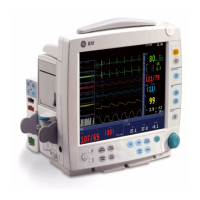Troubleshooting
10-7
Table 10-4 Other problems related to batteries
Table 10-5 Other problems related to ECG measurement
Table 10-6 Other problems related to impedance respiration measurement
Table 10-7 Other problems related to InvBP measurement
Symptom Possible cause and solution
Battery operation
time is markedly
shortened
• Condition the batteries according to the instructions in this
manual.
Symptom Possible cause and solution
ECG signal is
noisy or no QRS is
detected
• Ensure that the patient is not shivering.
Incorrect ECG filter.
• Check the filter through ECG - ECG Setup - Filter.
Poor electrode quality or wrong positioning.
• Check the electrodes and cables and their placement. See
section“ECG” for details.
• Change the lead.
• Remove the ECG cable from the connector and reinsert it.
Pacer markers are
not visible
• Check that:
- The pacer markers have been selected ON.
- The pacemaker has been adjusted correctly and not above R.
- The pacemaker functions correctly: ECG cables, electrodes and
setups are correct.
Thick ECG
baseline
ECG cable is looped.
Other electrical power cables are near the ECG leadwires.
Incorrect ECG filter.
Incorrect power frequency of the monitor.
Symptom Possible cause and solution
Respiration
measurement
fails
• Check the electrode quality and positioning.
• Adjust the detection limits. During ventilator-supported breathing, the
respiration calculation may count only ventilator-produced
inspirations and expirations.
• Other electrical devices may interfere with the measurement.
Symptom Possible cause and solution
InvBP readings
seem unstable
• Make sure there are no air bubbles in the transducer system. Flush
and zero.
• Place the transducer on the patient’s mid-heart level and zero.

